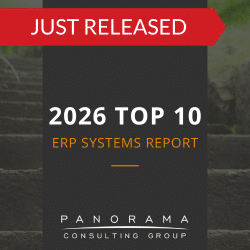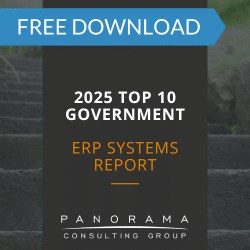Key Takeaways:
- Ranpak’s SAP implementation failure disrupted operations and financial reporting, revealing deeper misalignment between system design and business processes.
- The case illustrates how cloud ERP failure often stems from organizational issues—not software limitations.
- Strong ERP governance, change management, and post-go-live planning are essential to avoid implementation failures in packaging companies and beyond.
- Leaders should approach ERP selection and implementation as enterprise-wide transformation, leveraging independent ERP consulting services for risk mitigation and alignment.
From the outside, Ranpak looked ready. A global packaging company focused on sustainability and expanding worldwide had good reasons to update its systems. But as with many ERP initiatives, the software alone wasn’t the issue. The breakdown came from deeper, more strategic missteps.
In this post, we’ll unpack the key operational and strategic lessons from this cloud ERP failure, while focusing on broader ERP best practices: independent ERP selection, strong change management, and post-go-live optimization.
Contemplating litigation?
We have multiple software expert witnesses available for provision of reports, depositions, and testimonies.
What Went Wrong at Ranpak?
Ranpak’s 2023 SAP deployment spanned North America and Europe and was part of a broader digital transformation initiative.
According to public filings, the company encountered “unexpected challenges” during go-live, which ultimately affected its financial reporting, revenue recognition, and operational execution.
Ranpak’s leadership pointed to disruptions in order processing and billing accuracy as key issues. These were not just technical problems. They were also related to issues in data quality, collaboration, and operational visibility.
By the first quarter of 2024, the packaging company had to restate its earnings. The ERP failure forced Ranpak to reallocate resources to stabilize its systems.
From a strategic view, the most telling part of this failure was the lack of readiness in the organization to handle the change.
Lessons Learned From This SAP Implementation Failure
1. Cloud ERP Amplifies Misalignment
Ranpak’s case highlights a dynamic many organizations underestimate: cloud ERP accelerates change, but can also magnify internal misalignment.
Cloud systems like SAP S/4HANA introduce standardized processes, centralized data structures, and frequent updates. These features can improve efficiency, but only if your teams agree on ownership, data rules, and decision-making processes.
In Ranpak’s case, the cloud ERP failure created friction between legacy processes and new system expectations. Revenue recognition logic, order management workflows, and cross-border configurations all required precise alignment—something that cannot be reverse-engineered after go-live.
Takeaway: Before migrating to a cloud ERP system, we recommend building a foundation of governance, master data strategy, and cross-functional coordination. Treat ERP configuration as a reflection of enterprise alignment, not just system design.
2. “Go-Live Readiness” is an Executive Responsibility
The effort to go live with SAP involved months of planning, testing, and cross-team coordination. But readiness isn’t just a checklist; it’s a judgment call. And in Ranpak’s case, that call came too early.
Early signs of failure showed issues with order-to-cash processes and inventory errors. These issues were related to inadequate testing of real-world scenarios, insufficient validation of master data, and a lack of operational stress-testing..
We always advise executives to resist the urge to greenlight a go-live based solely on project milestones. Instead, we recommend pressure-testing readiness using real business complexity, like edge cases, exceptions, and operational scenarios that expose system limitations before they become enterprise risks.
Takeaway: Go-live is not a finish line. It is a live-fire test of whether your organization is capable of operating inside the new system. Executives must own that decision and the risk tolerance behind it.
3. ERP Failure is Often a Process Failure in Disguise
Packaging companies like Ranpak have complex operational needs, such as unit conversions, compliance constraints, regional logistics, and customer-specific packaging specs. If the ERP system fails to support these needs, it creates friction for the entire value chain.
We’ve seen the same pattern in many ERP consulting services engagements: the software behaves as designed, but business processes have not been adapted.
In Ranpak’s case, the disconnect affected billing, revenue tracking, and the company’s ability to trust its own financial data.
Takeaway: ERP success hinges on mapping business processes before they are digitized.
4. AI in ERP Cannot Fix What Governance Ignores
Many ERP vendors tout embedded AI as a safeguard against transactional errors and operational blind spots. But no amount of automation can compensate for unclear roles, fractured data ownership, or undefined escalation paths.
Ranpak’s SAP implementation failure revealed deeper governance issues. The company lacked guidelines for strategic decision-making, and as a result, the modern ERP system functioned more like a legacy system.
Takeaway: AI in ERP can enhance visibility and accelerate decisions, but it must be deployed on a foundation of strong governance and clear accountability.
5. The Stakes Increase After Go-Live
Ranpak’s ERP journey also underscores a truth we emphasize with clients: ERP vendor relationships matter even more after implementation because once the system is live, every misstep is amplified financially, operationally, and reputationally.
Once the system is live, any flaw can ripple across operations. In Ranpak’s case, those ripples became waves, requiring costly rework and pulling focus from growth initiatives. This kind of disruption often stems from weak post-go-live structures.
Takeaway: Build a formal post-go-live governance model. Include structured vendor engagement, internal SLA ownership, and scenario-based support plans.
Learn More About ERP Implementation Failure
Ranpak’s SAP implementation wasn’t doomed by software. It was undone by premature go-live decisions and weak governance.
These are fixable if surfaced early.
If your organization is exploring digital transformation or struggling with ERP risk, Panorama’s ERP consulting services offer vendor-agnostic, strategy-driven support. From ERP selection and implementation to post-go-live optimization, we help organizations avoid becoming the next cautionary tale. Contact us below to learn more.















